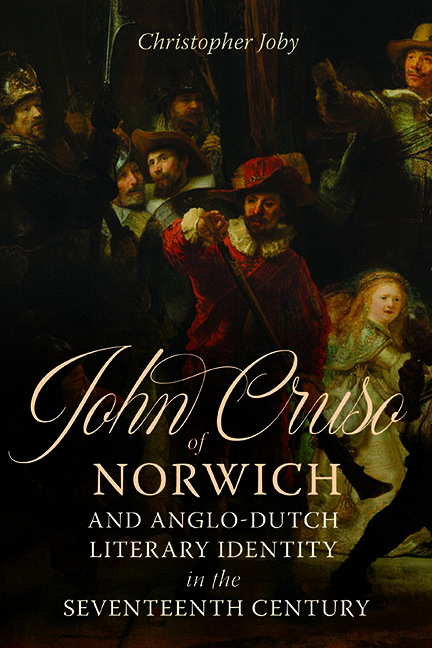Book contents
- Frontmatter
- Dedication
- Contents
- List of illustrations
- Acknowledgements
- Author’s note
- Abbreviations
- Prologue
- 1 Intrat John Cruso
- 2 John Cruso’s school days
- 3 John Cruso’s early adult life
- 4 Cruso’s elegy to Simeon Ruytinck (1622)
- 5 Cruso the English poet
- 6 1632 – Cruso’s annus mirabilis
- 7 Cruso the translator
- 8 Cruso’s 1642 Dutch verses: praise and lamentation
- 9 Cruso and the English Civil Wars
- 10 Cruso the Epigrammatist
- 11 Cruso’s final years
- Epilogue
- Appendix 1 Poems by John Cruso
- Appendix 2 Liminary verses in John Cruso’s English publications
- Bibliography
- Index
- Studies in Renaissance Literature
8 - Cruso’s 1642 Dutch verses: praise and lamentation
Published online by Cambridge University Press: 26 May 2022
- Frontmatter
- Dedication
- Contents
- List of illustrations
- Acknowledgements
- Author’s note
- Abbreviations
- Prologue
- 1 Intrat John Cruso
- 2 John Cruso’s school days
- 3 John Cruso’s early adult life
- 4 Cruso’s elegy to Simeon Ruytinck (1622)
- 5 Cruso the English poet
- 6 1632 – Cruso’s annus mirabilis
- 7 Cruso the translator
- 8 Cruso’s 1642 Dutch verses: praise and lamentation
- 9 Cruso and the English Civil Wars
- 10 Cruso the Epigrammatist
- 11 Cruso’s final years
- Epilogue
- Appendix 1 Poems by John Cruso
- Appendix 2 Liminary verses in John Cruso’s English publications
- Bibliography
- Index
- Studies in Renaissance Literature
Summary
1642 was another signal year for John Cruso. By now almost fifty, he published three further military works in English, Castrametation, Militarie Watches, and the second edition of The Art of Warre. In the same year, he published two more Dutch verses, one an elegy to the late minister of the Norwich Dutch church, Johannes Elison, and the other an amplificatio of Psalm 8, which probably marks a high point in his career as an occasional Dutch poet. Therefore, whilst he cemented his position as an important English military author, he continued to engage with his Netherlandish heritage.
The military books that Cruso published in 1642 are discussed in the next chapter. This chapter analyzes the two Dutch verses. Apart from being published in Dutch in the same year, the poems have several other things in common, but also differ in certain respects. Both are deeply religious. Cruso, the church elder, employed his extensive knowledge of the Bible to good effect in each poem and we could perhaps talk of him as a ‘lay theologian’ quaerens intellectum. Furthermore, Cruso presents himself as a Christian humanist, who could interweave themes from the Bible and classical antiquity to produce these poems, in the manner of Norwich textile workers weaving warp and weft on their looms to produce the cloth, which Cruso the merchant would transmute into specie. As Jan Bloemendal notes, a knowledge of these sources allowed authors to combine the values of the related notions of humanitas, the concept derived from antiquity that advocates good conduct, learning, and an awareness of other people, and charitas, the Christian love of one's neighbour. Furthermore, the poems are written in the same metre, the iambic hexameter or alexandrine. The carefully crafted alexandrines in these verses demonstrate both that Cruso was au courant with developments in Dutch Renaissance prosody and that he was an accomplished poetic technician.
But the verses also differ; one is an elegy, the other a poetic excursus or amplificatio of a well-known biblical text. The elegy is much shorter than the amplificatio of Psalm 8, and so draws on a narrower range of sources.
- Type
- Chapter
- Information
- Publisher: Boydell & BrewerPrint publication year: 2022

